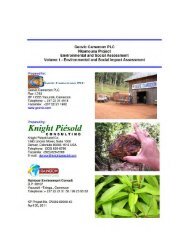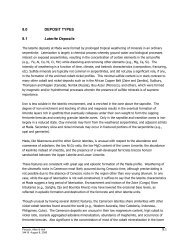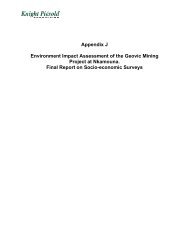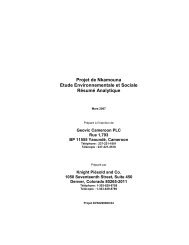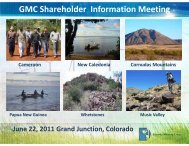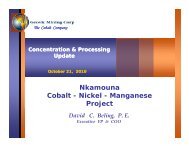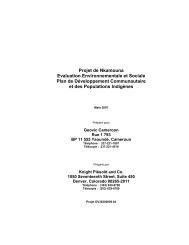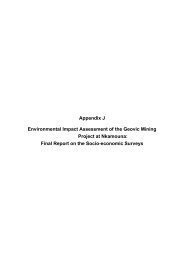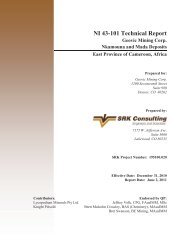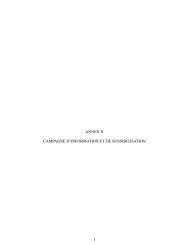Nkamouna Project Environmental & Social Assessment Executive ...
Nkamouna Project Environmental & Social Assessment Executive ...
Nkamouna Project Environmental & Social Assessment Executive ...
Create successful ePaper yourself
Turn your PDF publications into a flip-book with our unique Google optimized e-Paper software.
As set forth in the ESIA, proposed mitigation measures would require specific actions to ensure theirimplementation and monitoring to document their performance. These actions are further developed inthe ESAP (Section 4) and discussed in Section 3.2.2.7 Cumulative ImpactsPerformance Standard 1, <strong>Social</strong> and <strong>Environmental</strong> <strong>Assessment</strong> and Management Systems, requiresthat the risks and cumulative impacts be analyzed in terms of the <strong>Project</strong>'s area of influence. Past,existing, and future projects that have taken place or will take place within the <strong>Project</strong> area are basic toestablishing the spatial and temporal limits for cumulative impact analysis. Developments included in theanalysis must be realistically defined and described in order to establish a sensible analysis.Past activities in the area have been confined to commercial logging in which valuable timber specieswith a minimum diameter of 80 cm at breast height were selectively harvested.The current <strong>Project</strong> plan will result in the disturbance of approximately 720 ha at any given time. Ten to12 km 2 will be impacted over the projected mine life of 24 years. Concurrent reclamation of mined outareas to forest/wildlife habitat means that at the end of mining at 11 years, the <strong>Project</strong> area will comprisenumerous areas of reestablished forest at different stages of development.Reasonably foreseeable future impacts are associated with the development of the Mada deposit locatedto the north of the <strong>Nkamouna</strong> deposit and the other deposits in the mine permit that may be producedover the next 100 to 200 years.Development of the Mada and other deposits is expected to be subject to the same regulatory authorityas the current mining project and will be strongly linked with the current project.Mine development at Mada would entail the same actions as are currently undertaken for the current<strong>Project</strong>. Ore would be mined by standard open pit mining techniques using conventional miningequipment. Ore will then be trucked to the PUG Plant before being processed in the Leach Plant.Development plans for the remaining deposits have not been drawn up but will likely involve the samemining, treatment, and reclamation processes as at <strong>Nkamouna</strong>. The probable order of development willbe Rapodjombo, Mang North, Mang South, Messea, and, finally, Kondong. New processing facilities willhave to be constructed for exploitation of these deposits mainly due to long transport distances to the<strong>Nkamouna</strong> Plants. Current estimates indicate that development of these deposits will impact a further 300km 2 over several decades.Perhaps the most significant cumulative impact of adding the other deposits to the current <strong>Project</strong> plan isthe extension of the mine life on the order of 100 years. This will result in prolonged employment for themine work force and will continue GeoCam’s contributions to sustainable economic and communitydevelopment initiatives in the local communities.To enssure that the cumulative impacts of the development of all the deposits in the mining permit areadequately analyzed and that suitable plans are developed and implemented to mitigate their impact toacceptable levels, GeoCam will prepare:• ESIAs for each of the remaining six deposits that are in full conformance with GeoCam’s <strong>Environmental</strong>,Health and Safety, and <strong>Social</strong> Policy and Cameroon legislation. The <strong>Assessment</strong> will include baselinedata describing the relevant physical, biological and historical conditions and the environmental effectsassociated with project implementation. Mitigation measures needed to control those effects toacceptable levels will be included, as well as a more detailed analysis of the cumulative impacts and anevaluation of feasible alternatives. It will also include an ESAP that presents the environmentalmanagement, mitigation, monitoring and institutional measures to be taken during project<strong>Executive</strong> Summary, Rev 02-11



